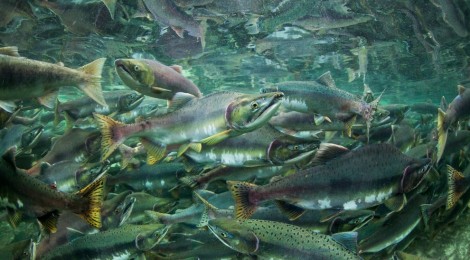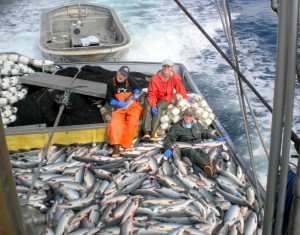
National Review Article
The Pacific’s Salmon Are Back — Thank Human Ingenuity
Haida tribe launched an effort to restore the salmon fishery that has provided much of their livelihood for centuries. They decided to support the efforts of American scientist-entrepreneur Russ George to demonstrate the feasibility of open-sea mariculture — in this case, the distribution of 120 tons of iron sulfate into the northeast Pacific to stimulate a phytoplankton bloom which in turn would provide ample food for baby salmon.
The verdict is now in on this highly controversial experiment: It worked. The fish came back.
Some additional excerpts:
In addition to producing salmon, this extraordinary experiment has yielded a huge amount of data. Within a few months after the ocean-fertilizing operation, NASA satellite images taken from orbit showed a powerful growth of phytoplankton in the waters that received the Haida’s iron.
It is now clear that, as hoped, these did indeed serve as a food source for zooplankton, which in turn provided nourishment for multitudes of young salmon, thereby restoring the depleted fishery and providing abundant food for larger fish and sea mammals.
In addition, since those diatoms that were not eaten went to the bottom, a large amount of carbon dioxide was sequestered in their calcium carbonate shells. Native Americans bringing back the salmon and preserving their way of life, while combating global warming: One would think that environmentalists would be very pleased.
Which is precisely why those demanding restraints on carbon emissions and restrictions on fisheries hate mariculture. They hate it for the same reason those demanding constraints in the name of allegedly limited energy resources hate nuclear power. They hate it because it solves a problem they need unsolved.
The ultimate question comes down to this: Are humans creators or destroyers? If it is accepted that we are simply agents of destruction, consuming or ruining resources that existed before we came, then it follows that human activities, numbers, and liberties must be severely constrained and that someone must be empowered to do the constraining.
On the other hand, if it is understood that humanity is fundamentally a creative force, that we invent resources and improve the world — unleashing abundance, lighting the night, ridding continents of pestilence, and bringing barren oceans to life — then it becomes clear that the essential mission of government is not to limit liberty, but to defend it at all costs.
—
Of course this isn’t just about salmon as the success of the work pioneers the way to replenish and restore ocean pastures around the world and repurpose a billion tonnes of CO2 from its harmful form into a billion fish to feed the world’s hungry.
Good news for Earth Day!
Here are a few comments from the National Review story:
Anne M • an hour ago
This is one of the most fascinating things I have read recently. Why is this not in the news? What a wonderful success story. It gives me hope for the future and is a powerful reminder of what human beings can accomplish. The opposition to this is horrifying and sickening. I will make a point of buying some Pacific salmon in the near future!
awfulorv • 20 hours ago
A wonderful story of human intellect, ingenuity, bravery, and common sense. On behalf of the fish who were fed,and grew to adulthood, and will now feed humanity, I applaud all who were part of this experiment.
blogagog • a day ago
“They hate it because it solves a problem they need unsolved.” Truer words are rarely spoken.
WEPNY russ george • a day ago
Mr. George – A very encouraging article indeed. I am additionally impressed that you have read readers’ comments and took the time to reply. Very gracious of you, making this into a variant of a conversation.


